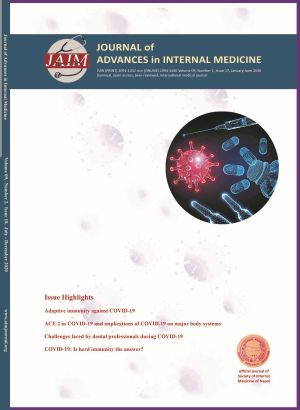Diagnostic Accuracy of Non-invasive Laboratory-Based Fibrosis Scores in Predicting the Presence of Esophageal Varices in Liver Cirrhosis
DOI:
https://doi.org/10.3126/jaim.v9i2.32814Keywords:
Cirrhosis, AAR, APRI, FIB-4, King Score, Lok scores, non-invasive predictorsAbstract
Introduction: Non-invasive assessment of esophageal varices (EVs) may reduce endoscopic burden and cost. This study aimed to evaluate the diagnostic accuracy of non-invasive fibrosis scores (AAR, APRI, FIB-4, King and Lok scores) for the prediction of varices in liver cirrhosis.
Methods: This prospective study included 100 liver cirrhosis patients who underwent screening endoscopy for EVs. AAR, APRI, FIB-4, King and Lok scores were assessed. The receiver operating characteristic curves (ROC) were plotted to measure and compare the performance of each score for predicting EVs and to obtain the corresponding optimal prediction value.
Results: Of the 100 patients, 70 were males and 30 were females with a mean age of 54.05±11.58 years. Esophageal varices were found in 77 patients out of which 58.44% were high-risk varices. Platelet count and non-invasive fibrosis scores APRI, FIB-4, Lok and King were able to discriminate patients with and without varices. Using area under receiver operating characteristic curve (AUROC), these scores were found to have low to moderate diagnostic accuracy for the presence of EVs and high-risk EVs, where the APRI score had the highest AUROC (0.77 and 0.70) respectively. At a cutoff value > 1.4, APRI score had 90.9% sensitivity, 60.9% specificity and 84 % diagnostic accuracy in predicting the presence of varices, while it had 84.4% sensitivity, 45.5% specificity and 63% diagnostic accuracy in predicting the presence of highrisk varices, at a cutoff value > 2.02.
Conclusion: APRI, AAR, FIB-4, King, and Lok scores had low to moderate diagnostic accuracy in predicting the presence of varices in liver cirrhosis. The APRI score can help select a patient for the endoscopy but cannot replace endoscopy for esophageal varices screening.
Downloads
Downloads
Published
How to Cite
Issue
Section
License
This license enables reusers to distribute, remix, adapt, and build upon the material in any medium or format, so long as attribution is given to the creator.




